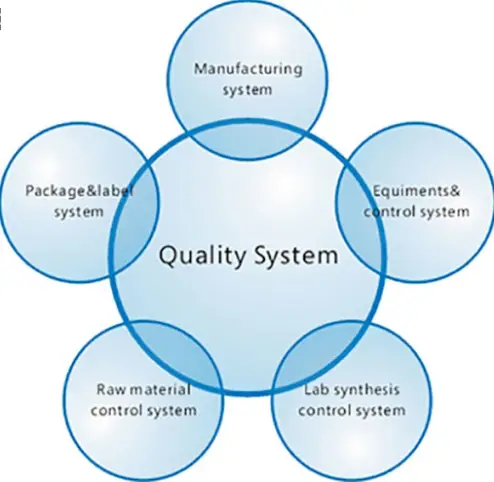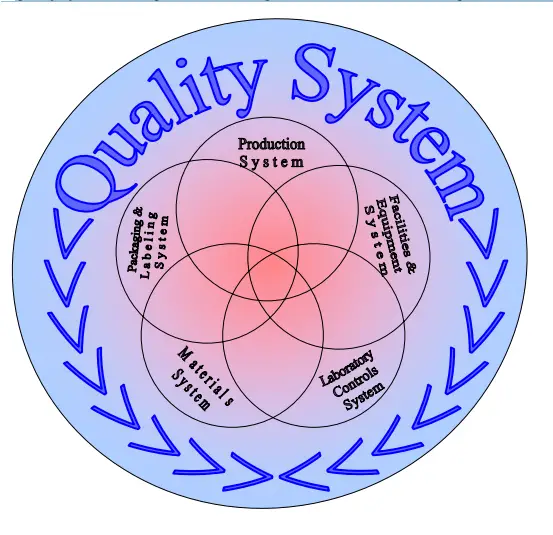CGMPS AND THE CONCEPTS OF MODERN QUALITY SYSTEMS
Quality should be built into the product, and testing alone cannot be relied on to ensure product quality.
Several key concepts are critical for any discussion of modern quality systems. The following concepts are used throughout this guidance as they relate to the manufacture of pharmaceutical products.
A. Quality
Every pharmaceutical product has established identity, strength, purity, and other quality characteristics designed to ensure the required levels of safety and effectiveness. For the purposes of this guidance document, the phrase achieving quality means achieving these characteristics for a product.
B. Quality by Design and Product Development
Quality by design means designing and developing a product and associated manufacturing processes that will be used during product development to ensure that the product consistently attains a predefined quality at the end of the manufacturing process. Quality by design, in conjunction with a quality system, provides a sound framework for the transfer of product knowledge and process understanding from drug development to the commercial manufacturing processes and for post-development changes and optimization.
The CGMP regulations, when viewed in their entirety, incorporate the concept of quality by design. This guidance describes how these elements fit together.
C. Quality Risk Management
Quality risk management is a valuable component of an effective quality systems framework. Quality risk management can, for example, help guide the setting of specifications and process parameters for drug manufacturing, assess and mitigate the risk of changing a process or specification, and determine the extent of discrepancy investigations and corrective actions.
D. CAPA (Corrective and Preventive Action)
CAPA is a well-known CGMP regulatory concept that focuses on investigating, understanding, and correcting discrepancies while attempting to prevent their recurrence. Quality system models discuss CAPA as three separate concepts, all of which are used in this guidance.
- Remedial corrections of an identified problem
- Root cause analysis with corrective action to help understand the cause of the deviation
- and potentially prevent recurrence of a similar problem
- Preventive action to avert recurrence of a similar potential problem
E. Change Control
Change control is another well-known CGMP concept that focuses on managing change to prevent unintended consequences. The CGMP regulations provide for change control primarily through the assigned responsibilities of the quality control unit. Certain major manufacturing changes (e.g., changes that alter specifications, a critical product attribute or bioavailability) require regulatory filings and prior regulatory approval (21 CFR 314.70, 514.8, and 601.12).
Effective change control activities (e.g., quality planning and control of revisions to specifications, process parameters, procedures) are key components of any quality system. In this guidance, change is discussed in terms of creating a regulatory environment that encourages change towards continual improvement. This means a manufacturer is empowered to make changes subject to the regulations based on the variability of materials used in manufacturing and process improvements resulting from knowledge gained during a product’s lifecycle.
F. The Quality Unit
Many of the modern quality system concepts described here correlate very closely with the CGMP regulations (refer to the charts later in the document). Current industry practice generally divides the responsibilities of the quality control unit (QCU), as defined in the CGMP regulations, between quality control (QC) and quality assurance (QA) functions.
• QC usually involves
(1) assessing the suitability of incoming components, containers,closures, labeling, in-process materials, and the finished products;
(2) evaluating the performance of the manufacturing process to ensure adherence to proper specifications
and limits; and
(3) determining the acceptability of each batch for release.
• QA primarily involves
(1) review and approval of all procedures related to production and maintenance,
(2) review of associated records, and
(3) auditing and performing/evaluating trend analyses.
This guidance uses the term quality unit (QU) to reflect modern practice while remaining consistent with the CGMP definition in § 210.3(b)(15). The concept of a quality unit is also consistent with modern quality systems in ensuring that the various operations associated with all systems are appropriately planned, approved, conducted, and monitored.
The CGMP regulations specifically assign the QU the authority to create, monitor, and implement a quality system. Such activities do not substitute for, or preclude, the daily responsibility of manufacturing personnel to build quality into the product. The QU should not take on the responsibilities of other units of a manufacturer’s organization, such as the responsibilities handled by manufacturing personnel, engineers, and development scientists.
Manufacturing personnel and the QU are both critical in fulfilling the manufacturer’s responsibility to produce quality products.
Other CGMP assigned responsibilities of the QU are consistent with modern quality system approaches (§ 211.22):
Ensuring that controls are implemented and completed satisfactorily during manufacturing operations
Ensuring that developed procedures and specifications are appropriate and followed, including those used by a firm under contract to the manufacturer Approving or rejecting incoming materials, in-process materials, and drug products Reviewing production records and investigating any unexplained discrepancies
Under a quality system, it is normally expected that the product and process development units, the manufacturing units, and the QU will remain independent. In very limited circumstances, a single individual can perform both production and quality functions.
That person is still accountable for implementing all the controls and reviewing the results of manufacture to ensure that product quality standards have been met. Under such circumstances, it is recommended that another qualified individual, not involved in the production operation, conduct an additional,
periodic review of QU activities.
G. Six-system Inspection Model
The FDA’s Drug Manufacturing Inspection Compliance Program, which contains instructions to
FDA personnel for conducting inspections, is a systems-based approach to inspection and is very consistent with the robust quality system model presented in this guidance.
The diagram below shows the relationship among the six systems: the quality system and the five manufacturing
systems. The quality system provides the foundation for the manufacturing systems that are linked and function within it. The quality system model described in this guidance does not consider the five manufacturing systems as discrete entities, but instead integrates them into appropriate sections of the model.
Those familiar with the six-system inspection approach will see organizational differences in this guidance; however, the inter-relationship should be readily apparent. One of the important themes of the systems based inspection compliance program is that you have the ability to assess whether each of the systems is in a state of control. The
quality system model presented in this guidance will also serve to help firms achieve this state of control.
Reference: Guidance for Industry -Quality Systems Approach to Pharmaceutical CGMP Regulations


